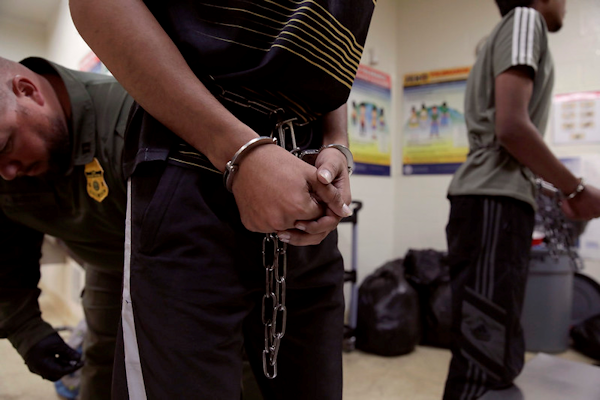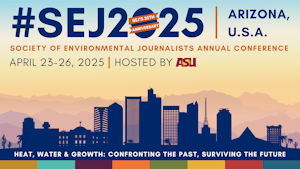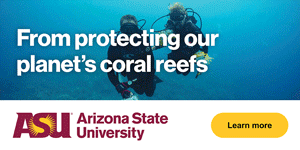SEJournal Online is the digital news magazine of the Society of Environmental Journalists. Learn more about SEJournal Online, including submission, subscription and advertising information.
 |
 |
| An undocumented immigrant being prepared for deportation from the New York border near Canada in September. Photo: U.S. Customs and Border Protection/Glenn Fawcett via Flickr Creative Commons (United States government work). |
Voices of Environmental Justice: Communities at Risk Are Climate Stories Too
By Yessenia Funes
In my 10 years in the journalism field, I’ve grown used to my profession’s echo chambers.
On the topic of climate and environment, for instance, journalists tend to focus on carbon emissions and clean energy policies. These are important, urgent topics. If world leaders fail to rein in fossil fuel pollution and transition to cleaner sources of energy, the planet as a whole is, well, screwed. So I get it.
These days, however, I’m thinking less about windmills and offshore oil leases. I’m too preoccupied worrying about the people stuck at the border, the families in fear of Immigration and Customs Enforcement knocking on their doors and the transgender children and adults across the country whose very existence is being threatened.
Donald Trump is president again, and he’s wasted no time this term making it clear who his targets are. In his first few days in office, he’d signed more than 20 executive orders (and the latest count, at publication time, is over 50). While an early one revoked protections for trans and nonbinary people, another deemed immigrants “terrorists” and “public safety threats.”
The safety and freedom of entire communities are at risk, yet most of what I’m hearing from my peers in climate and environmental journalism is concern over clean energy tax credits or wildlife.
I urge my colleagues to give equal weight
— if not more — in their reporting
to the threats the Trump administration
presents to human rights.
That fear is warranted: Trump is also inviting oil and gas drilling back to Alaska and closing the door on international climate negotiations. I urge my colleagues, however, to give equal weight — if not more — in their reporting to the threats the Trump administration presents to human rights.
Connecting the changing planet, changing communities
If you’re going to cover fossil fuels in Alaska or the U.S. withdrawal from the Paris Agreement, who will you interview to ensure the human impact isn’t lost in your story? How do we decenter Trump from the media narrative and focus, instead, on the people who are left suffering?
We have a responsibility to write a diverse array of stories even if our beats restrict our focus. We have a responsibility to the public and civic society to make connections between the planet’s changing nature and the changes communities are feeling at home.
Most importantly, we have a responsibility to the most vulnerable and oppressed in this nation and this globe. We’re failing to do our jobs if we abandon them when they need us the most.
I challenge us to find creative angles and
connections between our issue areas
and the real-time impacts of
Trump’s other devastating actions.
I challenge us to find creative angles and connections between our issue areas — be it energy, law, politics, pollution, business, conservation, finance or solutions — and the real-time impacts of Trump’s other devastating actions.
If you write about solar, what do mass deportations mean for the people who install that equipment? If you cover the courts, what legal precedent might judicial decisions on immigration or gender-affirming health care mean for environmental concerns?
I don’t know the answers here, but I raise these questions with the hope that you all will help shine a light on these connections.
Trump’s targeting of federal climate dollars
Across the country, grassroots organizations and the local people they serve are left scrambling as they lose critical access to federal dollars they were awaiting from the Inflation Reduction Act, former President Joe Biden’s landmark climate law that Trump has already frozen.
KD Chavez, the executive director of the environmental coalition Climate Justice Alliance, was preparing for this ahead of Trump’s inauguration. The president has already repealed the Justice40 Initiative, Biden’s program to allocate 40% of federal resources to disadvantaged communities (which I previously wrote about here), leaving a gap in funding for historically Black neighborhoods and other marginalized communities across the country.
“J40 is over,” Chavez said. “We’re going to see the plan of Project 2025 unravel and come after the folks who have received (Inflation Reduction Act) funds.”
She expects the Trump administration may target groups that have received those federal dollars. We’ll have to wait and see.
In lieu of Trump pausing that funding, however, she and the alliance’s member organizations have a monumental task ahead to find alternative sources through foundations and individual funders. The organization was supposed to receive funds, but the Biden administration never delivered those dollars before Trump entered office.
“It’s a matter of inaction being an action,” Chavez said.
These groups and the families they serve need our attention. What does this loss of funding look like on the ground? Journalists should be asking this question.
Trump’s attack on immigrant families
We should also be examining the ways climate change intersects with immigration, especially given the president’s attack on both.
Environmental journalists love to write about all the ways extreme weather events made worse by our planet’s heating, from drought to hurricanes, are driving migration. But they rarely look beyond that particular angle.
That story deserves coverage, but in the era of Trump, we should dig deeper. How will mass deportations hinder disaster recovery efforts, for example? Undocumented workers make up a large portion of that labor force.
Ahmed Gaya, the director of climate and migration for the pro-immigrant rights group National Partnership for New Americans, leads the organization’s Climate Justice Collaborative, where he works directly with people displaced by climate disasters.
‘We believe there’s an existential threat to both
the immigrant rights and climate movements.’
— Ahmed Gaya
“We believe there’s an existential threat to both the immigrant rights and climate movements,” Gaya said.
His organization advocates for mobility as a necessary form of climate adaptation. For example, the wildfires in Los Angeles have forced people in the city to move, sometimes to the opposite side of the country.
This is what the climate crisis is forcing onto families, but not everyone in the globe is free to find safety beyond their homelands. Not everyone has such an expansive country where they have options beyond what’s in front of them.
I think of my ancestral lands of El Salvador, a country no bigger than Massachusetts. There are only so many places a person can go within those borders.
“For us at the Climate Justice Collaborative, how we engage with climate becoming the largest driver of displacement in the world really shapes the kind of world that people live in and that we will give to our children,” Gaya said.
“Will we respond and adapt to that world in ways that are increasingly cruel and violent and inhumane by building walls and cages and guns?” he asked. “Or will we adapt to that world with interconnectedness and planning and resiliency in ways that strengthen multiracial democracy?”
Linking migration and climate
Jeff Ordower, the North American director of national climate organization 350, is working with other environmental and climate groups to build solidarity with immigrant rights groups.
First, there’s the educational component to catch up climate folks on the links between migration and climate. Then, there’s the effort to bring in nonclimate organizers so that they have a robust coalition for immigrant rights. Lastly, there’s a commitment to put their bodies on the line.
“I certainly hope you will see climate activists do what is necessary to protect people, protect families, stop family separations, stop deportations and do what we need to do,” Ordower said.
The climate movement has a rich history of civil disobedience, whether that’s setting up camps to stop the construction of oil and gas pipelines or locking arms to keep police officers at bay.
Ordower and his allies see a clear connection between the extractive apparatus that is building detention camps and prisons, and investing in surveillance technologies that threaten advocates’ right to peaceful protests.
“It’s important for us to keep our eyes on who is causing this,” he said.
Journalists need to show the public how climate change — and the people who dedicate their lives to the issue — connect back to these other equally urgent crises unfolding in the U.S. We can’t lose sight of our duty to the people.
The president wants to distract us. He wants us running like chickens with our heads cut off. We must refocus. We can’t abandon the people who need us the most.
If you’re looking for where to start your reporting, check out these resources:
- “Immigration Justice Must Be a Climate Fight, Too” by Ahmed Gaya and Jeff Ordower for Common Dreams
- “Climate Justice is Migrant Justice: Protecting People on the Move,” a webinar by the National Partnership for New Americans
- “Post-Disaster Climate Migration Messaging Guide” by the National Partnership for New Americans
Yessenia Funes is an environmental journalist who has covered the justice beat for a decade. She publishes a creative climate newsletter called Possibilities. Funes has written for publications like Atmos, Vogue, Vox, New York magazine, The Guardian and more. Her approach to storytelling amplifies the voices of those on the frontline of our present-day ecological crises. Her reporting has taken her to remote Indigenous communities in Nicaragua, the hostile desert of the American Southwest and post-Hurricane Maria Puerto Rico.
* From the weekly news magazine SEJournal Online, Vol. 10, No. 5. Content from each new issue of SEJournal Online is available to the public via the SEJournal Online main page. Subscribe to the e-newsletter here. And see past issues of the SEJournal archived here.













 Advertisement
Advertisement 



